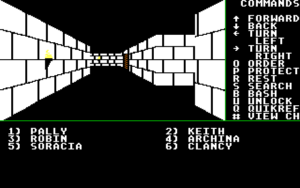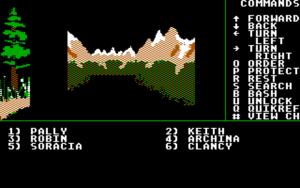Might and Magic, Book 1: Secret of the Inner Sanctum
I have to admit that what little I know about the Might and Magic series comes from its spin-off series, the Heroes of Might and Magic turn-based strategy games. I was curious enough about where it all came from to pick up the Ultimate Might and Magic Archives when it was released in 1998 as publicity for Might and Magic VI, but not curious enough to actually get around to playing it until now. Presumably the package was named by the same committee as the Ultimate Wizardry Archives; it isn’t exactly “ultimate” today, containing the first five of what is now a nine-game series. It’s a pretty nicely-put-together package, though, containing several handsome and colorful world maps on stiff paper, which fit neatly in a 6×9 envelope along with a compact booklet containing summarized instructions and spell descriptions. The full manuals are in PDF format on the disc, rather than in a thick book the way Ultimate Wizardry Archives did it.
Am I mentioning Wizardry a lot? I shall continue to do so. Might and Magic, it turns out, is a Wizardry clone. At the navigation level, it plays so much like Wizardry, with even the same visible distance and everything, that I’m finding the minor differences in the controls quite disconcerting. (Where in Wizardry the down-arrow key did an about-face, in M&M it moves you backward without turning.) I’ll note just three major differences that I’ve noticed so far in what little time I’ve spent playing:
 First and most visibly, there’s the graphics. Instead of line drawings, we get textures, like in The Bard’s Tale. Remember when I said that Wizardry‘s minimalism holds up better than more ambitious graphics from the same era? This game is a good example of what I was thinking of. The wall textures just scream “The programmer who drew me was really pushing the limits of Apple II hi-res mode!” The PC version is actually capable of running in 640×400 EGA mode 1[23 January] It turns out that EGA doesn’t have a 640×400 mode. I think the emulator I’m using is automatically upscaling. Still, it’s definitely using multiple pixels to represent each Apple II pixel. Apple II hi-res mode pixels are just freakishly elongated., but faithfully imitates the pixel size (and, where relevant, the dithering) of the Apple II version throughout, eight EGA pixels to every Apple one. Because this isn’t a perfect fit to the Apple pixel aspect ratio, the scenes are stretched out horizontally somewhat relative to the original. And yes, the game does credit the programmer as an artist. It also credits a couple of artists who aren’t credited as programmers, but I think they must have worked mostly on the monster illustrations.
First and most visibly, there’s the graphics. Instead of line drawings, we get textures, like in The Bard’s Tale. Remember when I said that Wizardry‘s minimalism holds up better than more ambitious graphics from the same era? This game is a good example of what I was thinking of. The wall textures just scream “The programmer who drew me was really pushing the limits of Apple II hi-res mode!” The PC version is actually capable of running in 640×400 EGA mode 1[23 January] It turns out that EGA doesn’t have a 640×400 mode. I think the emulator I’m using is automatically upscaling. Still, it’s definitely using multiple pixels to represent each Apple II pixel. Apple II hi-res mode pixels are just freakishly elongated., but faithfully imitates the pixel size (and, where relevant, the dithering) of the Apple II version throughout, eight EGA pixels to every Apple one. Because this isn’t a perfect fit to the Apple pixel aspect ratio, the scenes are stretched out horizontally somewhat relative to the original. And yes, the game does credit the programmer as an artist. It also credits a couple of artists who aren’t credited as programmers, but I think they must have worked mostly on the monster illustrations.
Secondly, the first-person view extends to more of the world than in Wizardry. The earlier Wizardry games, at least, are played entirely in the dungeon (even if they sometimes try to pretend that it’s something other than a dungeon); the town is nothing more than a series of text-based menus. In M&M, as in The Bard’s Tale before it, the towns (plural) are something you can explore, and where you can be attacked by monsters while walking around. Unlike The Bard’s Tale, though, the starting town looks like a dungeon. Enough so that it’s actually worked into the fiction: mention is made of how the towns moved underground as a defense against dragons.  The wilderness outside is also explorable, and rendered in the same engine, which looks fairly ludicrous: the world is plainly made of square partitions with pictures of forests and mountains wallpapered onto them.
The wilderness outside is also explorable, and rendered in the same engine, which looks fairly ludicrous: the world is plainly made of square partitions with pictures of forests and mountains wallpapered onto them.
Thirdly, the game is a great deal gentler than Wizardry. Characters reduced to zero hit points are not dead, but merely unconscious, and can be revived by means of a simple healing spell (even in the middle of combat). Even if you suffer a total party kill, the only consequence is that you start over from the last time you stopped at an inn. In this respect, it’s a lot more like a modern CRPG: nothing permanently bad happens. It’s making me a little worried, though: I created my current party thinking of it as a test run, but if they can’t get killed off for good, maybe I should have spent more time rerolling for better stats.
| ↑1 | [23 January] It turns out that EGA doesn’t have a 640×400 mode. I think the emulator I’m using is automatically upscaling. Still, it’s definitely using multiple pixels to represent each Apple II pixel. Apple II hi-res mode pixels are just freakishly elongated. |
|---|
 Comments(3)
Comments(3)